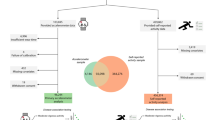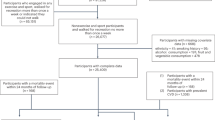Abstract
Use of wearable devices that monitor physical activity is projected to increase more than fivefold per half-decade1. We investigated how device-based physical activity energy expenditure (PAEE) and different intensity profiles were associated with all-cause mortality. We used a network harmonization approach to map dominant-wrist acceleration to PAEE in 96,476 UK Biobank participants (mean age 62 years, 56% female). We also calculated the fraction of PAEE accumulated from moderate-to-vigorous-intensity physical activity (MVPA). Over the median 3.1-year follow-up period (302,526 person-years), 732 deaths were recorded. Higher PAEE was associated with a lower hazard of all-cause mortality for a constant fraction of MVPA (for example, 21% (95% confidence interval 4–35%) lower hazard for 20 versus 15 kJ kg−1 d−1 PAEE with 10% from MVPA). Similarly, a higher MVPA fraction was associated with a lower hazard when PAEE remained constant (for example, 30% (8–47%) lower hazard when 20% versus 10% of a fixed 15 kJ kg−1 d−1 PAEE volume was from MVPA). Our results show that higher volumes of PAEE are associated with reduced mortality rates, and achieving the same volume through higher-intensity activity is associated with greater reductions than through lower-intensity activity. The linkage of device-measured activity to energy expenditure creates a framework for using wearables for personalized prevention.
This is a preview of subscription content, access via your institution
Access options
Access Nature and 54 other Nature Portfolio journals
Get Nature+, our best-value online-access subscription
$29.99 / 30 days
cancel any time
Subscribe to this journal
Receive 12 print issues and online access
$209.00 per year
only $17.42 per issue
Buy this article
- Purchase on Springer Link
- Instant access to full article PDF
Prices may be subject to local taxes which are calculated during checkout




Similar content being viewed by others
Data availability
The UK Biobank data that support the findings of this study can be accessed by researchers on application (https://www.ukbiobank.ac.uk/register-apply/). Variables derived specifically for this study will be returned along with the code to the UK Biobank for future applicants to request.
Code availability
Analysis code is available on request to the corresponding author.
References
Wearable Devices https://www.statista.com/study/15607/wearable-technology-statista-dossier/ (Statista, 2019).
Welk, G. J. et al. Standardizing analytic methods and reporting in activity monitor validation studies. Med. Sci. Sports Exerc. 51, 1767–1780 (2019).
Pate, R. R. et al. Physical activity and public health. A recommendation from the Centers for Disease Control and Prevention and the American College of Sports Medicine. J. Am. Med. Assoc. 273, 402–407 (1995).
US Department of Health and Human Services. 2008 Physical Activity Guidelines for Americans (Washington, DC, 2008).
World Health Organization. Global Recommendations on Physical Activity for Health (Geneva, 2010).
Department of Health. Start Active, Stay Active: A Report on Physical Activity from the Four Home Countries’ Chief Medical Officers (London, 2011).
Ainsworth, B. E. et al. Compendium of physical activities: a second update of codes and MET values. Med. Sci. Sports Exerc. 43, 1575–1581 (2011).
Physical Activity Guidelines Advisory Committee. 2018 Physical Activity Guidelines Advisory Committee Scientific Report (US Department of Health and Human Services, 2018).
Chastin, S. F. M. et al. How does light-intensity physical activity associate with adult cardiometabolic health and mortality? Systematic review with meta-analysis of experimental and observational studies. Br. J. Sports Med. 53, 370–376 (2019).
UK Chief Medical Officers’ Physical Activity Guidelines (Department of Health & Social Care, Welsh Government, Department of Health Northern Ireland & Scottish Government, 2019).
Lindsay, T. et al. Descriptive epidemiology of physical activity energy expenditure in UK adults (The Fenland Study). Int. J. Behav. Nutr. Phys. Act https://doi.org/10.1186/s12966-019-0882-6 (2019).
Schmid, D., Ricci, C., Baumeister, S. E. & Leitzmann, M. F. Replacing sedentary time with physical activity in relation to mortality. Med. Sci. Sports Exerc. 48, 1312–1319 (2016).
Wijndaele, K., Sharp, S. J., Wareham, N. J. & Brage, S. Mortality risk reductions from substituting screen time by discretionary activities. Med. Sci. Sports Exerc. 49, 1111–1119 (2017).
Matthews, C. E. et al. Accelerometer-measured dose-response for physical activity, sedentary time, and mortality in US adults. Am. J. Clin. Nutr. 104, 1424–1432 (2016).
Saint-Maurice, P. F., Troiano, R. P., Berrigan, D., Kraus, W. E. & Matthews, C. E. Volume of light versus moderate-to-vigorous physical activity: similar benefits for all-cause mortality? J. Am. Heart Assoc. https://doi.org/10.1161/JAHA.118.008815 (2018).
Dormann, C. F. et al. Collinearity: a review of methods to deal with it and a simulation study evaluating their performance. Ecography 36, 27–46 (2013).
Ekelund, U. et al. Dose-response associations between accelerometry measured physical activity and sedentary time and all cause mortality: systematic review and harmonised meta-analysis. Br. Med. J. 366, l4570 (2019).
Manson, J. E. et al. A prospective study of walking as compared with vigorous exercise in the prevention of coronary heart disease in women. N. Engl. J. Med. 341, 650–658 (1999).
Tanasescu, M. et al. Exercise type and intensity in relation to coronary heart disease in men. J. Am. Med. Assoc. 288, 1994–2000 (2002).
White, T. et al. Estimating energy expenditure from wrist and thigh accelerometry in free-living adults: a doubly labelled water study. Int. J. Obes. https://doi.org/10.1038/s41366-019-0352-x (2019).
White, T., Westgate, K., Wareham, N. J. & Brage, S. Estimation of physical activity energy expenditure during free-living from wrist accelerometry in UK adults. PLoS ONE 11, e0167472 (2016).
Tikkanen, E., Gustafsson, S. & Ingelsson, E. Associations of fitness, physical activity, strength, and genetic risk with cardiovascular disease: longitudinal analyses in the UK Biobank study. Circulation 137, 2583–2591 (2018).
Strain, T. et al. Impact of follow-up time and analytical approaches to account for reverse causality on the association between physical activity and health outcomes in UK Biobank. Int. J. Epidemiol. https://doi.org/10.1093/ije/dyz212 (2019).
Fry, A. et al. Comparison of sociodemographic and health-related characteristics of UK Biobank participants with those of the general population. Am. J. Epidemiol. 186, 1026–1034 (2017).
Brage, S. et al. Descriptive epidemiology of energy expenditure in the UK: findings from the National Diet and Nutrition Survey 2008–15. Int. J. Epidemiol. https://doi.org/10.1093/ije/dyaa005 (2020).
Shephard, R. J. Absolute versus relative intensity of physical activity in a dose-response context. Med. Sci. Sports Exerc. 33, S400–S420 (2001).
Shiroma, E. J., Sesso, H. D., Moorthy, M. V., Buring, J. E. & Lee, I. M. Do moderate-intensity and vigorous-intensity physical activities reduce mortality rates to the same extent? J. Am. Heart Assoc. 3, e000802 (2014).
Gebel, K., Ding, D. & Bauman, A. E. Volume and intensity of physical activity in a large population-based cohort of middle-aged and older Australians: prospective relationships with weight gain, and physical function. Prev. Med. 60, 131–133 (2014).
Sudlow, C. et al. UK Biobank: an open access resource for identifying the causes of a wide range of complex diseases of middle and old age. PLoS Med. 12, e1001779 (2015).
van Hees, V. T. et al. Autocalibration of accelerometer data for free-living physical activity assessment using local gravity and temperature: an evaluation on four continents. J. Appl. Physiol. 117, 738–744 (2014).
Doherty, A. et al. Large scale population assessment of physical activity using wrist worn accelerometers: the UK Biobank study. PLoS ONE 12, e0169649 (2017).
van Hees, V. T. et al. Separating movement and gravity components in an acceleration signal and implications for the assessment of human daily physical activity. PLoS ONE 8, e61691 (2013).
Pearce, M. et al. Network harmonization of physical activity variables through indirect validation. J. Meas. Phys. Behav. https://doi.org/10.1123/jmpb.2019-0001 (2019).
Klass, M., Faoro, V. & Carpentier, A. Assessment of energy expenditure during high intensity cycling and running using a heart rate and activity monitor in young active adults. PLoS ONE 14, e0224948 (2019).
Brage, S. et al. Estimation of free-living energy expenditure by heart rate and movement sensing: a doubly-labelled water study. PLoS ONE 10, e0137206 (2015).
Brage, S. et al. Hierarchy of individual calibration levels for heart rate and accelerometry to measure physical activity. J. Appl. Physiol. 103, 682–692 (2007).
Thompson, D., Batterham, A. M., Bock, S., Robson, C. & Stokes, K. Assessment of low-to-moderate intensity physical activity thermogenesis in young adults using synchronized heart rate and accelerometry with branched-equation modeling. J. Nutr. 136, 1037–1042 (2006).
Brage, S. et al. Branched equation modeling of simultaneous accelerometry and heart rate monitoring improves estimate of directly measured physical activity energy expenditure. J. Appl. Physiol. 96, 343–351 (2004).
Strath, S. J., Brage, S. & Ekelund, U. Integration of physiological and accelerometer data to improve physical activity assessment. Med. Sci. Sports Exerc. 37, S563–S571 (2005).
White, I. R. & Royston, P. Imputing missing covariate values for the Cox model. Stat. Med. 28, 1982–1998 (2009).
Acknowledgements
We are grateful to the participants of the UK Biobank study and those who collected and managed the data. This work was conducted under UK Biobank application number 20684. T.S., K.W., S.B., S.J.S., T.L., P.C.D., M.P., J.J. and N.W. are supported by the UK Medical Research Council (unit program numbers MC_UU_12015/1 and MC_UU_12015/3). P.C.D. is supported by a National Health and Medical Research Council of Australia research fellowship (no. 1142685). T.L. is supported by the Cambridge Trust and St Catharine’s College.
Author information
Authors and Affiliations
Contributions
S.B., T.S., K.W. and P.C.D. designed the study with input from T.L., J.J., M.P. and N.W. T.S. undertook the analyses with assistance from S.J.S. T.S. drafted the manuscript. All authors contributed to the critical revision and approved the final version. T.S. had full access to all of the data in the study and takes responsibility for the integrity of the data and accuracy of the data analysis.
Corresponding author
Ethics declarations
Competing interests
The authors declare no competing interests.
Additional information
Peer review information Jennifer Sargent was the primary editor on this article and managed its editorial process and peer review in collaboration with the rest of the editorial team.
Publisher’s note Springer Nature remains neutral with regard to jurisdictional claims in published maps and institutional affiliations.
Extended data
Extended Data Fig. 1 Flowchart of participant exclusions.
Numbers and reasons for participant exclusions.
Extended Data Fig. 2
Change in covariates between baseline and visit 2 measurement for those in the main analysis sample that undertook both visits (n = 8,503).
Extended Data Fig. 3
Change in covariates between baseline and visit 3 measurement for those in the main analysis sample that undertook both visits (n = 15,140).
Extended Data Fig. 4
Descriptive statistics for the season of wear variable.
Extended Data Fig. 5
Scatter plot of physical activity energy expenditure versus fraction of physical activity energy expenditure from moderate-to-vigorous-intensity physical activity for the main analysis sample and the two excluded participants (n = 96,478).
Extended Data Fig. 6
Timeline of recruitment and data collection for participants in the main analyses of the present study.
Supplementary information
Supplementary Information
Supplementary Tables 1–8.
Rights and permissions
About this article
Cite this article
Strain, T., Wijndaele, K., Dempsey, P.C. et al. Wearable-device-measured physical activity and future health risk. Nat Med 26, 1385–1391 (2020). https://doi.org/10.1038/s41591-020-1012-3
Received:
Accepted:
Published:
Issue Date:
DOI: https://doi.org/10.1038/s41591-020-1012-3
This article is cited by
-
Accelerometer-measured physical activity, sedentary behavior, and risk of incident pelvic organ prolapse: a prospective cohort study in the UK Biobank
International Journal of Behavioral Nutrition and Physical Activity (2024)
-
Joint associations of leisure-time physical activity and sitting time with emotional wellbeing, physical functioning and work ability: an occupational study among young and early midlife Finnish municipal employees
Journal of Activity, Sedentary and Sleep Behaviors (2023)
-
Dose–response relationship between device-measured physical activity and incident type 2 diabetes: findings from the UK Biobank prospective cohort study
BMC Medicine (2023)
-
Day-to-day regularity and diurnal switching of physical activity reduce depression-related behaviors: a time-series analysis of wearable device data
BMC Public Health (2023)
-
Associations of timing of physical activity with all-cause and cause-specific mortality in a prospective cohort study
Nature Communications (2023)



